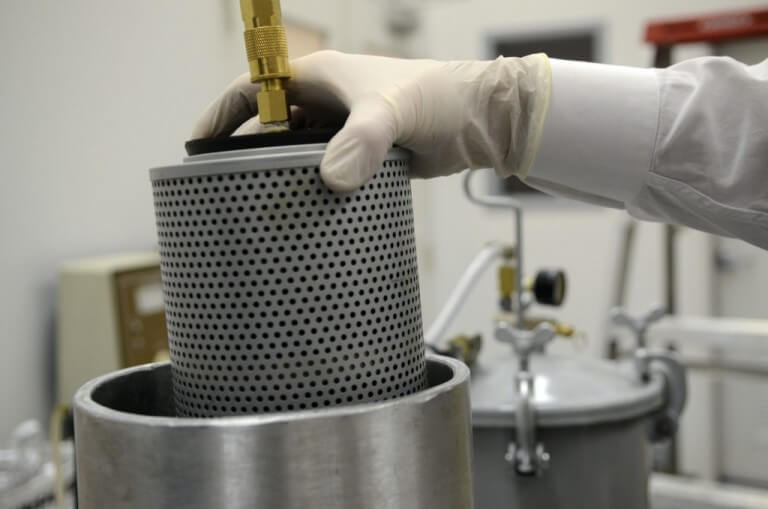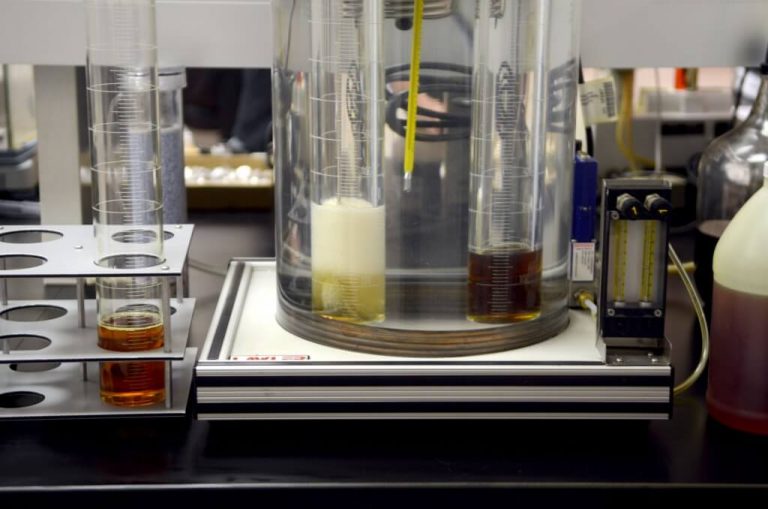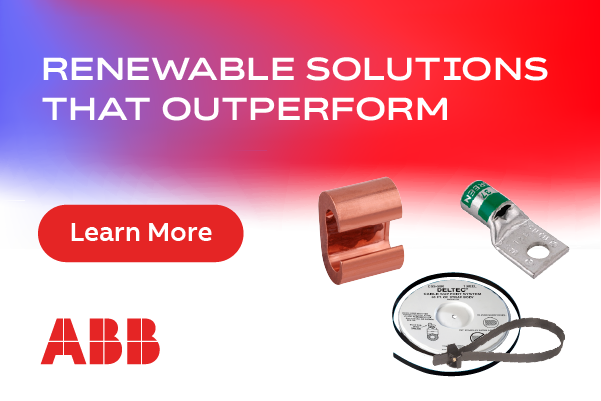Extreme Testing: When operating conditions for wind turbines call for advanced oil analysis
Advanced oil analysis tests for wind turbines should be conducted whenever a routine test picks up a significant anomaly, when trending analysis flags a pending negative condition, or when the manufacturer notifies operators of a possible defect that warrants a closer look. Following are three advanced oil analysis tests that make sense for wind turbines.

Filter debris analysis
Filter debris analysis (FDA) identifies abnormal wear in critical operational assets by measuring specific wear metals captured in the filter. A systematic process, similar to that used in the military, has been developed to wash and analyze the types of filters most commonly used in wind turbines. Advantages of FDA include:
- The full-flow nature of the filter element allows all the fluid in the system to pass through the filter element, providing an accurate assessment of the fluid and equipment condition.
- The coherent surface for capturing fluid system debris efficiently over time results in a high concentration of debris, compared to debris in the fluid or in magnetic plugs/chip detectors.
- The filter element retains debris of all types (metallic and nonmetallic).
With traditional oil analysis, the only particles available for analysis are those circulating in the oil (smaller than the filter size) or immediately released in the oil prior to filtering. Given the fine filtration used in today’s wind turbine gearboxes, 95 percent of the wear debris that could provide useful insight into machinery condition is caught in the filter, and never ends up in an oil sample. Typically, this valuable debris is discarded with the filter. FDA captures this lost information to identify the specific components that are wearing, providing improved diagnostic and prognostic information about impending failures.
Foam
ASTM D892 measures the foaming tendency of a lubricant. Even though foaming is a fundamental physical property of a lubricating fluid, the tendency of oils to foam can be a serious problem in systems such as high-speed gearing, high-volume pumping, and splash lubrication. Inadequate lubrication, loss of lubricant, and cavitation can lead to mechanical failure. Cavitation is the formation of air or vapor bubbles in the fluid due to lowering of pressure in a liquid; these bubbles then collapse (implode) in the higher-pressure regions of the oil system. The implosion can be powerful enough to create holes or pits — even in hardened metal — if the implosion occurs at the metal surface. This type of wear is most common in hydraulic pumps, especially those that have restricted suction inlets or are operating at high elevations.
ASTM D892 measures foam by three sequences that differ only in testing temperature.
- Sequence I measures the foaming tendency and stability at 24°C (75°F).
- Sequence II uses 93.5°C (200°F).
- Sequence III uses the same conditions as Sequence I, except it’s performed on fluid that has just been measured in Sequence II.
The fluid sample from Sequence I is only used for that test. The fluid sample used in Sequence II is carried into Sequence III. The results are reported as two numbers for each sequence. For example: 20/0 means 20 milliliters of foam tendency was measured after 5 minutes of aeration followed by no foam stability (0 ml) after the 10-minute settling time. Most new oil specifications require 10 to 50 milliliters tendency maximum and 0 milliliters stability.

Compatibility testing
Almost everyone that has worked in the reliability field has either experienced or heard about a lubrication problem brought on by combining incompatible lubricants. Sometimes this is accidental, such as a leaking hydraulic line dripping onto a gearbox. Other causes are intentional, i.e., the plant wants to consolidate the number of lubricants in use, the current product is discontinued, or there are supply chain issues. In any case, compatibility testing is required.
Problems with compatibility include excessive foaming, precipitate or deposit formation, and loss of essential performance traits such water separability. It’s also important to remember that “equivalent” or “comparable” lubricants are not the same as compatible lubricants. Two considerations for determining the best compatibility test or test slate are:
- Decide if you will test your current in-use fluid with the replacement fluid(s). If you have one lubricant system that’s transitioning to a new oil, it’s a good idea to test the used fluid with the replacement fluid. This will detect any possible incompatibilities between the used oil and new oil. If you have multiple systems that will be changing to the new oil, then comparing a new oil sample of the fluid currently in use in the machines to a new oil sample of the replacement fluid will provide a basic determination of compatibility. Alternatively, a used oil sample from each of the systems can be tested with the replacement fluid.
- Determine which mixtures you would like tested. ASTM D7155 calls for at least one mixture in the ratio of 50:50. Additional mixtures can be added if appropriate. Even with a complete change out, some residual fluid may be present in the system and could mix with the new fluid. In that case, adding a mixture of 90 percent new oil to 10 percent used oil is recommended. If the replacement fluid will be gradually added to the existing fluid, then three mixtures are recommended, either 90:10, 50:50, and 10:90 or 25:75, 50:50, and 75:25.
Compatibility testing will identify incompatible lubricants before they are mixed in equipment and cause operational issues. Alternative choices can then be evaluated so that a suitable replacement can be selected. While lubricant compatibility testing cannot guarantee compatibility, it can predict it.
Depending on the specific type of equipment and suspected issues, there are a number of other advanced oil analysis tests that could be run on wind turbines. The key is to work with a trusted lab for all testing, both advanced and routine.
 Mary Messuti is the President of Eurofins TestOil, Inc. located in Strongsville, Ohio. Her lab offers a full line of lubrication testing as well as fuel, coolant, grease, and associated tribology services. Mary holds a BS in Industrial Engineering from West Virginia University and an MS in Operations Management from Rensselaer Polytechnic Institute in NY. She also holds a certificate in Investment Banking from NYU, as well as various other accreditations such as MLTI, PMP, and Senior SHRM certification. She has a passion for Reliability Engineering and Asset Management. Mary enjoys over 25 years of experience in laboratory management and heavy industrial/aerospace manufacturing environments.
Mary Messuti is the President of Eurofins TestOil, Inc. located in Strongsville, Ohio. Her lab offers a full line of lubrication testing as well as fuel, coolant, grease, and associated tribology services. Mary holds a BS in Industrial Engineering from West Virginia University and an MS in Operations Management from Rensselaer Polytechnic Institute in NY. She also holds a certificate in Investment Banking from NYU, as well as various other accreditations such as MLTI, PMP, and Senior SHRM certification. She has a passion for Reliability Engineering and Asset Management. Mary enjoys over 25 years of experience in laboratory management and heavy industrial/aerospace manufacturing environments.
Eurofins TestOil, Inc. | www.testoil.com
Author: Mary Messuti
Volume: 2024 September/October








